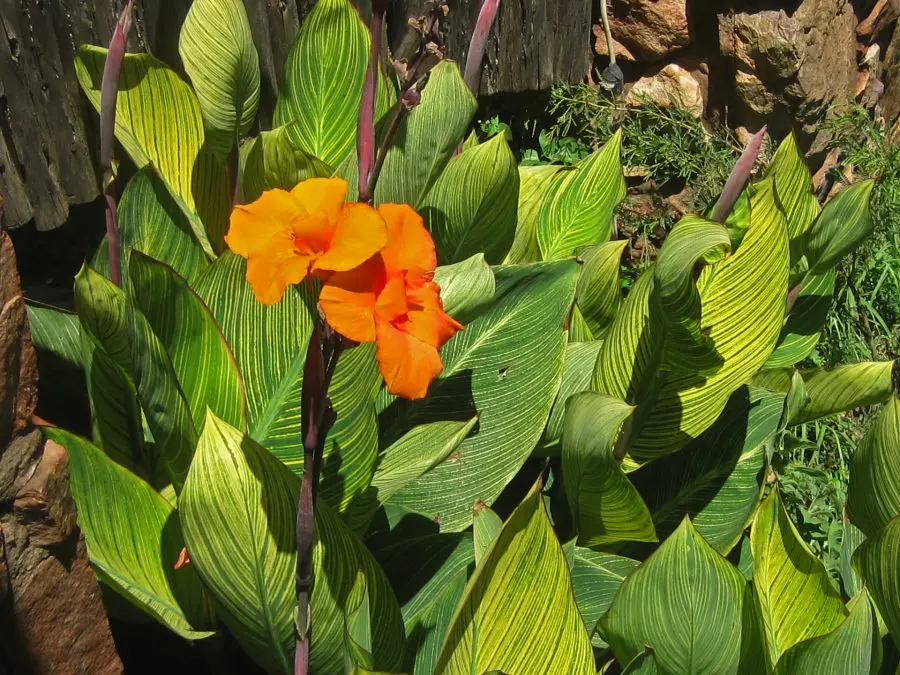This post contains affiliate links. If you buy something from one of our links we may earn a commission. Thanks

Canna Lilies are a popular choice for indoor gardening due to their striking beauty and ease of care.
But even with their low maintenance reputation, it’s important to learn about canna lily care indoors and follow proper care techniques to ensure your Canna Lilies thrive and bring a touch of the outdoors into your home.
Growing indoor Canna Lilies requires a well-draining potting mix, a pot with drainage holes, and a sunny spot. Water them regularly but allow the soil to dry out between waterings. Fertilize monthly with a balanced fertilizer during growing season, and reduce watering in the winter.
In this blog, we’ll uncover 5 secrets to thriving indoor Canna Lilies that will make all the difference in the health and appearance of your plants.
From choosing the right soil and pot to providing adequate light, watering correctly, fertilizing regularly, and pruning and propagating, these tips will help you take your indoor canna lily care to the next level.
So, whether you’re a seasoned indoor gardener or a new plant parent, keep reading to discover the secrets to a thriving indoor Canna Lily garden.
Growing Canna Lilies Indoors
Canna lilies are tropical plants grown outdoors after all danger of frost is passed. Some gardeners will harvest the tubers and bring in plants to overwinter them in a dark place in colder climates.
Canna plants can survive winter in hardiness zone 7 and above but they should be mulched to protect them from cold temperatures.
Outdoors canna lily bulbs are planted in late spring. But you can grow canna lilies in pots indoors year-round.
You can have canna flowers even during the winter months.
Probably the biggest secret of all is that Cannas plants are perennial and will grow and flower year-round if you take care of them properly.
We will show you how to grow canna lilies indoors and enjoy the beautiful tropical leaves and flowers these plants have to offer.
What Are Canna Lilies?
Canna Lilies are a group of tropical and subtropical flowering plants that are prized for their bold, bright flowers, large leaves, and lush foliage. Cannas are native to warmer climates in South America.
They are easy-to-grow plants that can add a touch of tropical charm to any indoor setting. Canna bulbs are actually rhizomes and readily available.
Their foliage and growth habit reminds me of a banana tree. But some varieties offer striking and colorful foliage and they will be attractive on their own. Add to this the beautiful flowers and these are a must-have indoor plant.
Check out the foliage color on this Tropicanna canna lily plant.
According to Wikipedia, the Canna or canna lily is the only genus of flowering plants in the family Cannaceae, consisting of 10 species. Cannas are not true lilies.
Importance Of Proper Care For indoor Canna Lilies
While Canna Lilies are relatively low-maintenance plants, proper care is crucial for ensuring their health and beauty. Without the right conditions, your Canna Lilies may become stunted, develop yellow leaves, or even fail to bloom.
Dwarf Canna Lily Care
Regular canna lilies can get 4-7 feet tall but there are dwarf varieties of canna lilies that will be 2-3 feet tall. They make a fantastic tropical focal point for any room.
Personally, I prefer full-sized canna lily plants and enjoy the tropical look they add but if you are short on space or only have a windowsill dwarf cannas will be a perfect choice. Dwarf canna lily care is no different than growing a full-sized canna.
Here is a Picasso flowering dwarf canna lily.
Canna Lily Care Indoors: 5 Secrets to Thriving Flowers
In this blog, we’ll delve into 5 essential secrets to thriving indoor Canna Lilies. From choosing the right soil and pot to providing adequate light, proper watering, regular fertilization, and pruning and propagation, these tips will help you create a healthy and vibrant indoor canna lily garden.
Rhizomes, Seeds And Live Plants
Most canna lilies are sold as bulbs or tubers but actually, they are rhizomes. They are often sold as live plants at local garden centers during their outdoor growing season.
I prefer buying tubers because live plants can harbor insect pests or diseases.
They also allow you to start your canna lily at any time of year and are usually cheaper than live plants.
Canna lilies can also be started from seeds but will take much longer before they flower. Seeds can vary greatly and might not produce the flower colors or foliage you want.
By the end of this post, you’ll have all the tools you need to keep your Canna Lilies thriving for years to come.
Secret #1: Growing Canna Lilies In Pots – Choose the Right Soil and Pot
The Ideal Soil For Canna Lilies
The ideal soil for Canna Lilies should be rich in organic matter and well-draining. Canna Lilies require moist soil, but they are susceptible to root rot if the soil stays too wet for too long.
To prevent this, choose soil that contains a mix of sand, peat moss, and compost to ensure good drainage.
I find a coco coir and perlite mix is superior and in fact, if you use coco coir you can skip the perlite as it is well draining on its own.
Coco has excellent water retention properties so you may need to water less often, particularly if you don’t add any perlite.
Importance Of Using A Well-Draining Pot
 To promote good soil drainage, it’s important to use a well-draining pot for your indoor Canna Lilies.
To promote good soil drainage, it’s important to use a well-draining pot for your indoor Canna Lilies.
A pot with drainage holes in the bottom is ideal to prevent water from accumulating in the soil and causing root rot.
Pot Size
For the best results, choose a pot that is slightly larger than the root ball of your Canna Lily.
Canna lilies are spread by underground rhizomes so you can use a large container that is wider than your plant to keep things from getting crowded and allow the rhizomes to spread.
You can also separate the rhizomes from the mother plant and use them to start more plants.
A terracotta or plastic pot with good drainage holes is ideal. I prefer plastic pots. Terracotta plants can wick away moisture and make watering more often necessary.
For soil, choose a high-quality potting mix that contains organic matter and perlite to ensure good drainage.
Avoid using garden soil, as it may be too heavy and compact for indoor use.
How To Plant Canna Lily Rhizomes:
• Choose a location with full sun and a pot filled with well-drained soil.
• Dig a hole 4-6 inches deep and place the rhizome horizontally with the buds facing up.
• Cover with soil and gently press down to secure the rhizome in place.
• Canna rhizomes may take up to 3-5 weeks to sprout new leaves.
• Warm soil temperature can speed this up.
• Water thoroughly and regularly, especially during dry spells.
• Fertilize monthly with a balanced fertilizer during the growing season.
Secret #2: Provide Adequate Light
The Ideal Lighting For Canna Lilies
Canna Lilies are native to tropical regions and require 6-8 hours of direct sunlight to thrive indoors.
They can tolerate some partial shade but low light levels may keep them from flowering.
Tips For Positioning Your Canna Lily
The ideal light for indoor Canna Lilies is bright direct light. To ensure your indoor Canna Lilies receive enough light, place them near a bright, south-facing window.
If you don’t have access to a bright window, you can also use grow lights to provide the light your plants need to thrive.
Problems With Insufficient Light For Canna Lilies
Without enough light, your indoor Canna Lilies may become stunted, develop yellow leaves, and fail to bloom.
Additionally, insufficient light can make the plants more susceptible to disease and pests.
By providing the right amount of light, you’ll help ensure your Canna Lilies are healthy and vigorous.
Secret #3: Proper Watering
Canna Lilies prefer evenly moist soil and require consistent watering. But you want to avoid soggy soil.
The ideal watering schedule for indoor Canna Lilies is to water them when the top inch of soil has become dry to the touch.
Water thoroughly, making sure the water reaches the roots, and then let the soil drain before returning the pot to its saucer.
Signs Of Overwatering And Underwatering
Over-watering is one of the biggest threats to indoor Canna Lilies and can lead to root rot.
To prevent over-watering, make sure the pot has good drainage and don’t allow the soil to become waterlogged.
On the other hand, under-watering can cause yellowing leaves, stunted growth, and reduced blooms.
To prevent under-watering, make sure to keep the soil consistently moist and adjust your watering schedule as needed.
Tips For Watering
To maintain the right moisture level, stick your finger in the soil to check for moisture. Water your indoor Canna Lilies when the top inch of soil is dry to the touch.
Make sure to water thoroughly, but avoid over-watering, which can lead to root rot.
Consider using a moisture meter to help you keep track of the soil moisture level and ensure your plants receive the right amount of water.
Secret #4: Fertilize Regularly
The Benefits Of Fertilization
Fertilization is an important aspect of Canna Lily care indoors and provides the plants with the nutrients they need to grow strong and produce healthy blooms.
Fertilizing regularly helps ensure that your Canna Lilies receive the right balance of nutrients for optimal growth and blooming.
Recommendations For The Type Of Fertilizer To Use
 A water-soluble, balanced fertilizer that is high in nitrogen is ideal for indoor Canna Lilies.
A water-soluble, balanced fertilizer that is high in nitrogen is ideal for indoor Canna Lilies.
You can also use a balanced slow-release fertilizer, or choose a fertilizer specifically designed for flowering plants.
Follow the manufacturer’s instructions for determining the right amount of fertilizer to use.
A general rule of thumb is to fertilize indoor Canna Lilies every two weeks during the growing season, from spring to fall.
If you use a slow-release fertilizer you will only need to fertilize every 6 months.
During the winter, when the plants are dormant, you can reduce the frequency of fertilization or stop fertilizing altogether.
Always dilute the fertilizer as directed and avoid over-fertilizing, which can damage the roots and harm the plant.
Secret #5: Prune and Propagate
The Benefits Of Pruning And Propagating
Pruning and propagating are important techniques for maintaining healthy indoor Canna Lilies.
Pruning helps promote bushier growth and encourages the plants to produce more blooms.
Propagating allows you to create new plants from existing ones, which can help you save money and expand your indoor garden.
The Right Time To Prune And Propagate
Canna Lilies should be pruned in the spring, after they have finished blooming. This encourages new growth and helps keep the plants compact and bushy.
Propagating can be done at any time, but the best time is in the early spring or summer when the plants are actively growing.
Instructions For Pruning And Propagating
To prune indoor Canna Lilies, cut back the flower stalks that have finished flowering to just above the soil line.
This is called deadheading and if these branches are left they will start to grow seeds and draw energy away from the rest of the plant.
Removing them will encourage new growth and promote bushier growth.
To propagate, you can also remove some rhizomes from the mother plant to create new plants.
Canna Lilies Indoors FAQs
Canna Lilies, with their tropical allure, bring a burst of color and a hint of the exotic to any indoor setting.
However, like any plant brought indoors, they have a set of requirements to flourish away from their natural habitat.
Common inquiries surrounding their care regimen – watering, sunlight, soil type, and fertilization form the crux of these queries.
As you venture into growing Canna Lilies indoors, understanding their needs will be your stepping stone to seeing them thrive and brighten your living space.
Let’s address some of the common questions associated with nurturing these tropical beauties indoors.
Q. What type of soil is best for indoor Canna Lilies?
A. A well-draining potting mix is ideal for indoor Canna Lilies to prevent waterlogging and root rot. Coco coir and perlite make an excellent potting medium.
Q. How much sunlight do indoor Canna Lilies require?
A. Canna Lilies thrive in bright light; placing them near a south or west-facing window where they can get at least 4-6 hours of sunlight is beneficial. You can use an LED grow light for supplementation.
Q. How often should I water my indoor Canna Lilies?
A. Watering should be regular, but it’s crucial to let the soil dry out between waterings to prevent over-watering.
Q. What type of fertilizer is suitable for indoor Canna Lilies, and how often should they be fertilized?
A. A balanced fertilizer, applied monthly during the growing season, will provide the necessary nutrients for your indoor Canna Lilies to flourish.
Growing Canna Lilies Indoors Final Thoughts
In this post, we covered the 5 secrets to thriving indoor Canna Lilies: choosing the right soil and pot, providing adequate light, proper watering, fertilizing regularly, and pruning and propagating.
Each of these secrets plays an important role in ensuring that your Canna Lilies are healthy and bloom beautifully.
Now that you know the secrets to canna lily care indoors, it’s time to put them into practice!
By following the tips outlined in this post, you can ensure that your Canna Lilies thrive and bloom beautifully. So, get started today!
Canna Lilies are a beautiful and low-maintenance addition to any indoor garden. By following the 5 secrets outlined in this post, you can ensure that your Canna Lilies thrive and bloom beautifully.
Not sure growing plants indoors is for you? Read more about the 20 Benefits Of Keeping Indoor Plants For Improved Lifestyle. Let’s get growing!










